For a four year period beginning in 1982, Certified Parts Corporation of Janesville, Wis., and its owner, Jim Grafft, were an integral, brand-saving chapter in the Arctic Cat story.
For a short history CPC and how I ended up there, please CLICK HERE for Episode 1 of CPC Revisited.
To see what we uncovered at the first warehouse where we met Grafft, CLICK HERE for Episode 2.
HERE in Episode 3 – A Barn Full of Sleds, you can see some truly delicious artifacts, including a prototype and some legendary Sno Pro hoods.
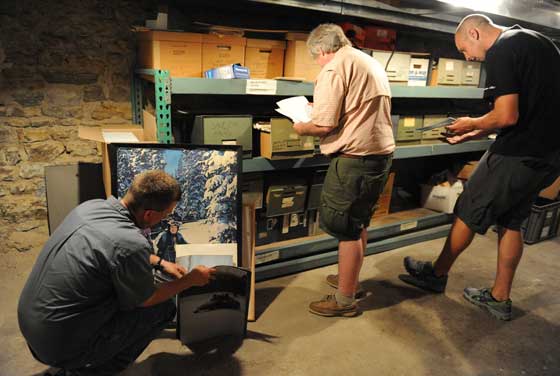
After having spent the first part of the day looking at warehouses and a “barn” full of snowmobiles, the second half was spent below ground in several of Grafft’s buildings where he stores much of the documentation of the various companies he purchased, including Arctic Cat.
Standing in these dimly-lit basements and lightly sorting through boxes and stacks of artifacts, it all felt like an archaeological dig.
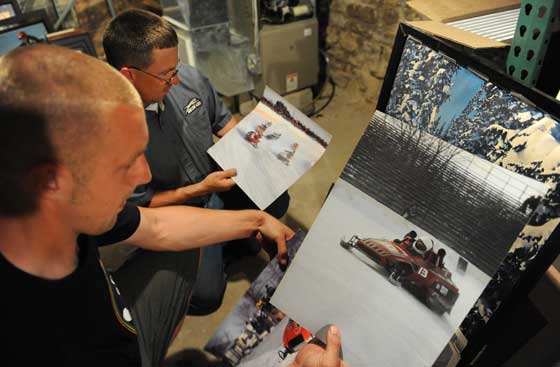
Here Eric Bergstrom (foreground) and Tom Rowland peruse some of the original print film used for the various CPC calendars from the 1980s.
I’m pretty sure that most of the photos used in those calendars were taken by Jim Beilke of Race & Rally/Snow Tech magazine. Next time I see someone from that crew, I’ll confirm.

It’s likely that this is the hat Jim Grafft wore when Arctic Cat celebrated restarting snowmobile production in Thief River Falls for the 1984 model year.

Some artwork of a prototype twin-track vehicle that appears to be from Speedway, one of the companies that CPC purchased.
It’s interesting how many different companies have played with the concept of a sit-in, twin-track snowmobile.
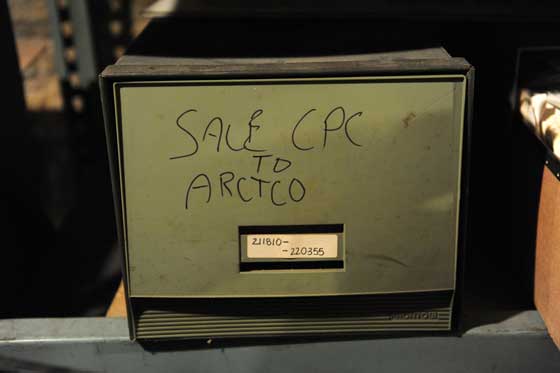
For historians of the sport, seeing a file box like this is truly just as fascinating as seeing one of Bob Elsner’s 1979 Arctic Cat Sno Pro hoods.

Grafft opened some of the files and paged through some of the information, including this document which appeared to be something of a prospectus that Arctic Enterprises prepared when it was trying to find a buyer in late 1981.
It’s not detectable in the photo, but I’m pretty sure that Rowland was salivating.
In all seriousness, this was another watershed moment during our day with Grafft, as there has long been (and probably always will be) so little public information about production numbers, future snowmobile plans and other such information from the waning days of Arctic Enterprises.
Seeing some actual documentation was a rare and amazing treat.

I’m sure Rowland will comment here, but this was the first time he had ever seen production numbers for the 1980 and ’81!
(Note: it’s my hunch that these production numbers correspond to the model year, not the calendar year in which they were produced.)
Again, this page was one of many from batch that Arctic Enterprises prepared as it was trying to find a buyer. Perhaps the numbers aren’t exact, but they must certainly be close.
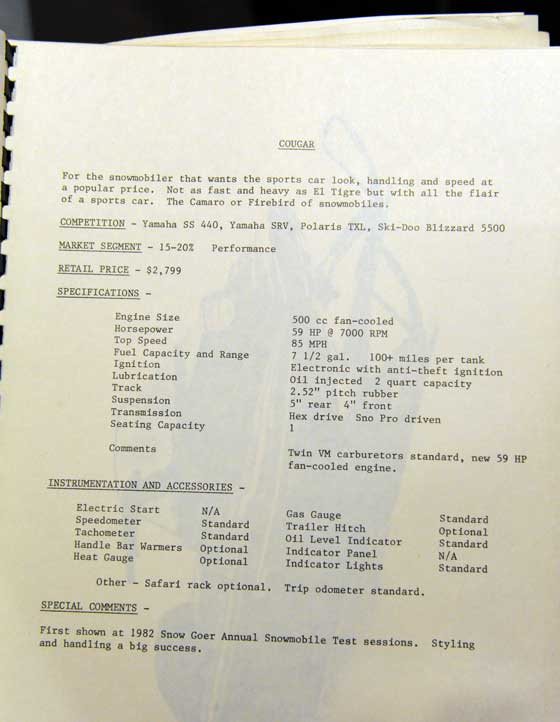
In the same document was this page highlighting the planned-for-1982 Arctic Cat Cougar.
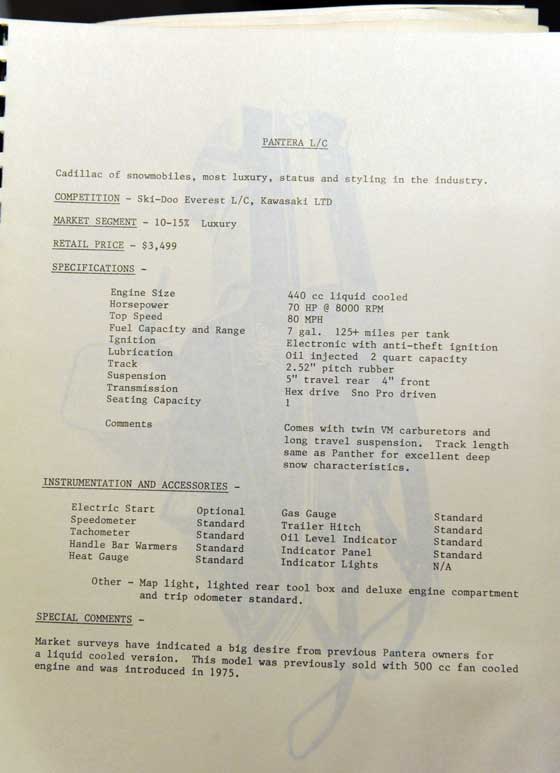
Likewise, here is documentation for what would have been the first liquid-cooled Pantera, for the 1982 season.
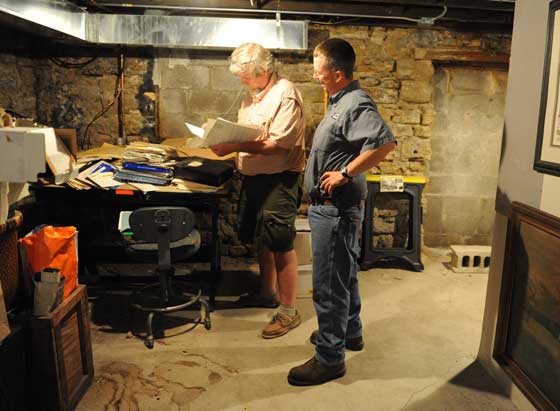
Grafft was quite gracious to allow us this peek into his private records. And though we would have liked to have spent a day or two pouring over the info in hopes of sharing it, we were Jim’s guests. He was understandably tentative about diving into this stuff.
So when he indicated that it was time to move on, we simply acknowledged our appreciation that we were able to see the artifacts that we did.
Our next and final stop for the day was a different warehouse, where once again we descended deep into a dimly-lit basement where Grafft had stored more items from his purchase of various snowmobile companies.
Seriously, the last basement we entered had just one working ceiling light. Using the flashlight feature on our phones (until the batteries were all but zapped) we dug through shelves and boxes and found a few final treasures.
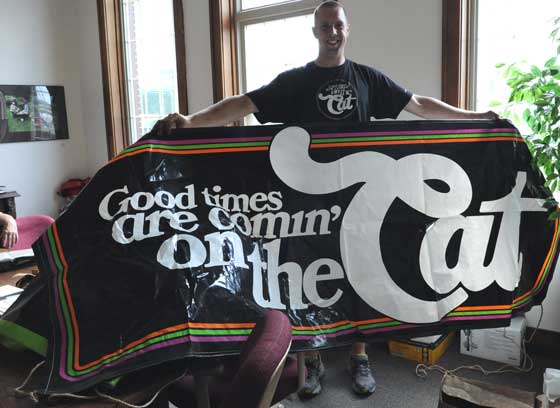
Righteous that Bergstrom discovered a banner that matched his wardrobe!
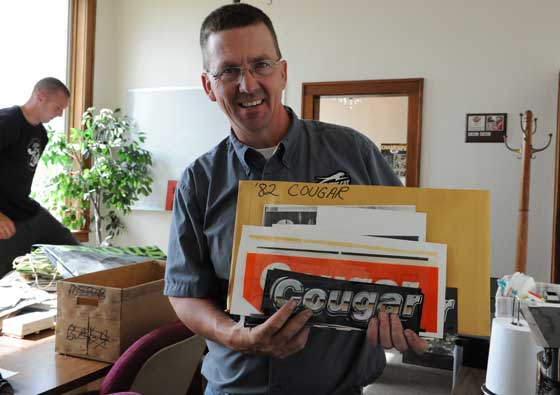
I’m not sure what pleased Rowland more, discovering a prototype single-cylinder Lynx, seeing the Sno Pro hoods of Jim Dimmerman and Bob Elsner, finding the production numbers for the 1980 and ’81 model Arctic Cats, or discovering a box that contained a folder of the graphics for the 1982 Arctic Cat Cougar.
The thing is, Rowland actually owns one of the prototype ’82 Cougars, yet his doesn’t have the dash/console graphic. And inside this folder, he found a template for the graphic, which he made a copy of and will have reproduced to help complete his sled.
Likewise, the folder contained several “Cougar” concept decals, including the mostly-white decal you see here. Seeing these artifacts is like going back in time and sort of witnessing those final days of Arctic Enterprises.
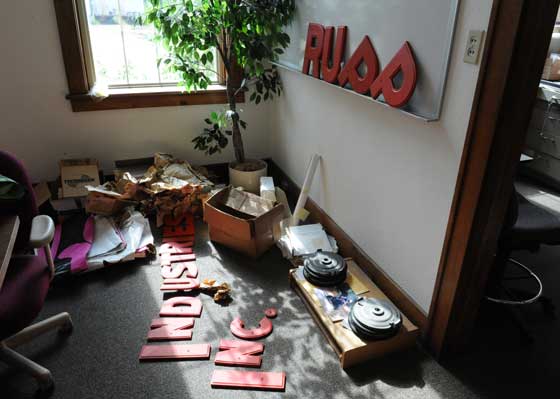
One of the coolest discoveries was a box that contained the letters that spelled “RUPP Industries Inc.” on the company’s snowmobile production building in Mansfield, Ohio.
Two comments I want to make about this:
First, I loved Rupps. I think company founder Mickey Rupp absolutely had a passion for designing cool motorsports products.
Second, I felt a bit melancholy about seeing this box full of letters, knowing what hopes and dreams were extinguished prior to them being pulled off the building that they once graced. In that moment I also felt such deep gratitude that history unfolded the way it did, and that Arctic Cat was reborn.
Arctic Cat could have ended up like Rupp, but it didn’t. And I am so profoundly thankful for that.
I’ll talk a little bit more about that sentiment in the next (and last) Episode.
Thanks for reading.



Mr. Grafft, on behalf of longtime CAT fans everywhere thanks for letting these guys into your buildings and allowing them to share your treasures with us.
David
Hey Tom Rowland! I sure miss that 82 Cougar you bought off me! But so glad it went to you and congrates on the sweet find!
Ed
As stated above…It was indeed very gracious of Mr Grafft to share so much with us that day, I do not take that lightly.
Edmund, let me know when you can visit central MN sometime in the winter. I’ll have a few of the 1982 Cats gassed up, we’ll go get a trailside burger and a Monster.
As John states in this segment, this is the first production numbers I have ever seen for the 1980 and 1981 model years. Only 500 Jag Long Tracks produced…I always thought they seemed rare, now I see why with only 500 produced. I now wonder how many of those 500 went to the Scandanavian market and how many stayed here in the US? I am only aware of 3 here in the US so far, I am not done looking though.
It is published that 1000 Scorpions were produced by Arctic for the 1981 model year. I am guessing that then is the production number for the sought-after 1981 Scorpion Sidewinder model? Thats not too many either, has many have already speculated.
The drop in production from the 1980 model year to 1981 is huge! When everything is taken into account that is already spoken of in history books…lack of snow, high interest rates, petroleum concerns, etc, etc…no wonder those were turbulent times in the snowmobile industry.
John, thanks for taking the time to share this great story with all of us.
I’d also like to express my thanks to Jim Grafft for his part in keeping Arctic Cat alive. I know Polaris was lurking in the shadows trying to aquire the assets of Arctic Enterprises and it makes you wonder if Arctic Cat would have suffered the same fate as the John Deere snowmobile line after Polaris bought them.
Hi Guys..This has been a great story…but I,am afraid I have to rain on your parade a little.. 1* Bob Elsner does NOT and has NEVER owned his 79 WC sled.(its not in his garage either). 2* Their NEVER was a 82 prototype Sno Pro sled/hood or anything else.(we knew the company was going to close before we even started the 81 season) 3* I think Al Enno made 81 hoods without the radiator cutout for drag racing,and that team arctic decal in not correct for 81. Other than a few minor details I think this is THE best barn find of the decade.. Thanks for taking the trip to show us all !! Jim
Hmmm…
Jim, Do you know where Elsner’s sled is?
The sled wasn’t given to him after the ’79 season?
Hey John,
I think I,ll pass on the where-abouts of the sled.
Unfortunately Arctic did not give it to him either.
I know for a fact that Bobby does not have any of his “old stuff”.
He is doing fine, just quitely retired…( the old man is 70 now )
Dang…this is like watching an episode of Myth Busters…lol. Thanks for posting your insight Jim, is helpful to hear from those of you that were involved during that era. The “proto 1982 Sno Pro” thing had almost taken on an urban legend status…seems like that can be put to rest for good.
Jim,
Thanks for posting. In my opinion, you can rain on any parade you want. It’s nice to learn the facts and I’m glad you cleared some things up! One question I had though, was whether the ’78 or ’79 hoods lent any clues as to which size machine they may have come off of? It was just a curiosity of mine… I’m kind of a sno pro novice.
Thanks!
Eric
Ok Jim! Where did the Elsner Derby winner go!
Hey Eric,
The hoods themselves were the same for each model year,for example the 78 did not have the radiator shroud. That was added in 79. Both year sleds would have had a SM/ I,II, or III decal posted up by the radiator on the back side tword the driver. In 78 our 250 cc or SM/ I sleds had a Champion spark plug sticker up by the driver,s name. The other engines had NGK.( Ritchie Porter the engine man said we got about a 1.5 horsepower gain on the 250 engine with Champion plugs). Just a little trivia for you….Jim
Fun stuff! Thanks Jim!
Hi everyone. I love these historic flashbacks. There is one 1979 sno pro in
sweden that was raced by Bob Elsner. Would there be any easy way recognise the ER winner?